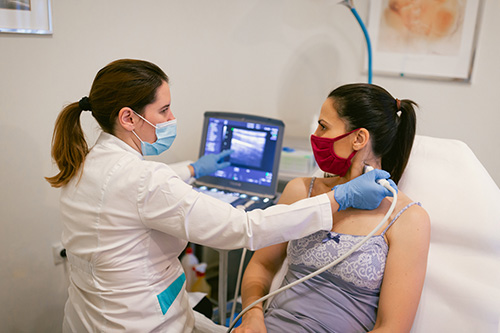Reviewed by Dr. Mary James, ND
Testing for thyroid function has become controversial. For many years the conventional thyroid test has measured thyroid stimulating hormone (TSH), the hormone excreted by the pituitary gland to stimulate the thyroid. The theory was that high TSH levels in the blood indicate a sluggish thyroid that needs a push to get its job done.
In this simplistic approach, the range of TSH levels that is considered “normal” can be quite wide. Many labs in the US consider a TSH of 0.5–5.0 to be within normal range. Within this “normal” range, many practitioners won’t diagnose a thyroid problem like hypothyroidism even if it actually is struggling. Outside this range many practitioners will diagnose thyroid disease and write a one-size-fits-all prescription for a synthetic thyroid supplement, usually Synthroid, Levoxyl, or Levothyroid.

Our approach to the thyroid test
In publishing new clinical guidelines in 2002, the American Association of Clinical Endocrinologists fairly dramatically formalized a reversal of its previous doctrine, establishing a narrower “normal” TSH margin of 0.3–3.04. In our view, a woman’s TSH level should ideally be less than 2.0, but she should also be thriving and free from hypothyroidism symptoms. If she reports symptoms, or shows a TSH level greater than 2.0, she may have subclinical or clinical hypothyroidism.
For women with more pronounced hypothyroidism symptoms, we feel that the TSH test is inadequate because it doesn’t tell us enough about the underlying problem. To do that, we need more detailed hormone tests to show what the thyroid is producing and what is available for the body to use.
The predominant product of the thyroid is T4 (thyroxine), which is then converted by the liver into the usable form T3 (triiodothyronine). There are many causes of inadequate T4 production, including adrenal stress, poor nutrition, and autoimmune thyroid disease. Similarly, many factors cause inadequate conversion of T4 into T3, including lack of adequate nutrients and minerals and poor liver function.
There are blood tests now that provide a complete picture of how well the thyroid produces T4, how much of the active form T3 is created, how well the body converts and uses the T3, and whether there are significant anti-thyroid antibodies present. One is the Comprehensive Thyroid Assessment blood panel from Genova Diagnostics. Ask your practitioner if he or she is familiar with it, or find a practitioner who is.
A skilled practitioner can also learn a great deal from a woman’s medical history and physical examination, especially by gathering information about her skin, eyes, hair, energy level, bowel habits, and body temperature.
In many cases a thyroid disorder is actually an indication of imbalance in some other body system. For example, adrenal stress impairs thyroid function. Excess cortisol blocks the efficient conversion and peripheral cellular use of the thyroid hormones at many levels. For this reason evaluating and, when appropriate, testing saliva for adrenal function may be done in combination with thyroid testing.
Testing saliva or blood for progesterone levels during the luteal phase (second half) of the menstrual cycle may also be of great value. If excess estrogen in relation to progesterone levels is found to be negatively impacting the thyroid, gentle progesterone supplementation can be implemented.
1 American Association of Clinical Endocrinologists. 2002. AACE Medical guidelines for clinical practice for the evaluation and treatment of hyperthyroidism and hypothyroidism. Endocrine Practice, 8 (6).
American Association of Clinical Endocrinologists. 2003. Over 13 million Americans with thyroid disease remain undiagnosed. URL: https://www.aace.com/newsroom/press/2003/
index.php?r=20030118 (accessed 02.27.2007).










